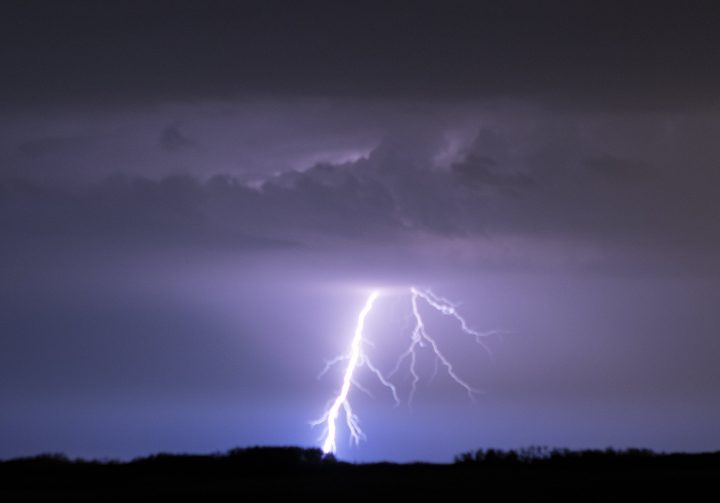A bolt of lightning has been deemed the cause of a house fire during a thunderstorm in Saskatchewan on Wednesday.

A caller reported to the Saskatoon Fire Department at 10:40 p.m. that smoke was exiting the roof around five kilometres south of the city in the rural municipality of Corman Park.
Firefighters found a small fire in the attic and quickly put it out using a manual pump tank. The fire department said all affected insulation and charred building material was fully extinguished and removed from the structure.
“Lightning strikes that cause damage to structures like homes or buildings are extremely rare in Saskatchewan.”
Environment and Climate Change Canada meteorologist Terri Lang said on Thursday that these types of fires happen every year, but odds are lightning won’t strike or cause damage to houses.
- Canadian man dies during Texas Ironman event. His widow wants answers as to why
- ‘Shock and disbelief’ after Manitoba school trustee’s Indigenous comments
- Several baby products have been recalled by Health Canada. Here’s the list
- ‘Sciatica was gone’: hospital performs robot-assisted spinal surgery in Canadian first
“Lightning tends to strike higher objects, buildings, trees, poles, that type of thing, and because we’re so flat here on the Prairies, our houses and our trees and such tend to be the taller objects. It’s not necessarily the case, but it sometimes can be the case,” she said.
“We don’t get a lot of them just because we’re so wide open on the Prairies.”
The meteorologist said on Wednesday night there were 7,129 lightning strikes within 50 kilometres of Saskatoon.
“That’s a fairly high number of lightning strikes so with that, the odds do increase… I’ve seen a lot more, but there was quite a bit of lightning, fairly active with respect to lightning last night,” Lang said.
Lang pulled up the home’s address on South Point Drive in the Ashwood Estates district using the federal department’s system and said she saw a clump of strikes prior to the 911 call.
“I can count probably at least 10 lightning strikes in there that could have caused that,” Lang said.
“These were recorded just before 10:18 p.m. So that makes sense based on… sometimes these things can happen where the lightning will strike the house and it will go inside of the house and kind of simmer and then will start on fire. So sometimes it can occur way after the fact.”
Lang said the federal department has a network of sensors across Canada that use triangulation and the waveform of the lightning strike to figure out where they occur.
“There is some leeway… we can get it within a certain range. Our detection efficiency is within half a kilometre,” she said.
Lang said lightning bolts heat up to about 30,000 degrees Celsius, about five times the temperature of the sun, in a fraction of a second.
“The band which the lightning travels — the path, the channel — is only about the width of two pencils. Even though it looks a lot bigger… but the amount of current that comes to a lightning strike varies quite a bit,” she said.
The fire department said two people safely evacuated the house to a safe location with their two dogs.
Lang said houses provide great protection but noted that if lightning strikes it, electricity can travel through the metal piping so people shouldn’t shower during a thunderstorm.
“The two safest places in a lightning storm are in a car — not a convertible, not a golf cart — an enclosed car or in a building because it will shelter you… There is no safe place outside in the lightning storm,” Lang said.
“We always say ‘when thunder roars, go indoors.’ If you can see lightning, if you can hear thunder, it’s time. That’s when it’s time to seek shelter. Not when the storm is hitting you,” she said.
Lang said recent statistics show two to three people are killed in Canada every year from lightning and 180 are injured.
“It kills more people on average than tornadoes or any other type of summer severe weather combined. So for people who don’t view lightning as dangerous: it is dangerous,” she said.
For the latest conditions and warnings, download the SkyTracker weather app.




Comments